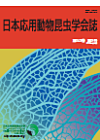Volume 58, Issue 3
Displaying 1-21 of 21 articles from this issue
- |<
- <
- 1
- >
- >|
Special Articles: Recent Progress in Pest Management using Artificial Light and Colors
Original Articles
-
Article type: Original Article
2014Volume 58Issue 3 Pages 177-185
Published: August 25, 2014
Released on J-STAGE: November 15, 2014
Download PDF (1299K) -
Article type: Original Article
2014Volume 58Issue 3 Pages 187-195
Published: August 25, 2014
Released on J-STAGE: November 15, 2014
Download PDF (4526K) -
Article type: Original Article
2014Volume 58Issue 3 Pages 197-201
Published: August 25, 2014
Released on J-STAGE: November 15, 2014
Download PDF (3776K) -
Article type: Original Article
2014Volume 58Issue 3 Pages 203-209
Published: August 25, 2014
Released on J-STAGE: November 15, 2014
Download PDF (3149K) -
Article type: Original Article
2014Volume 58Issue 3 Pages 211-216
Published: August 25, 2014
Released on J-STAGE: November 15, 2014
Download PDF (728K)
Reviews: Regional Topics on Pest Control Research in Japan
-
Article type: Review
2014Volume 58Issue 3 Pages 217-236
Published: August 25, 2014
Released on J-STAGE: November 15, 2014
Download PDF (1442K)
Original Articles
-
Article type: Original Article
2014Volume 58Issue 3 Pages 237-247
Published: August 25, 2014
Released on J-STAGE: November 15, 2014
Download PDF (1006K) -
Article type: Original Article
2014Volume 58Issue 3 Pages 249-253
Published: August 25, 2014
Released on J-STAGE: November 15, 2014
Download PDF (498K) -
Article type: Original Article
2014Volume 58Issue 3 Pages 255-262
Published: August 25, 2014
Released on J-STAGE: November 15, 2014
Download PDF (494K) -
Article type: Original Article
2014Volume 58Issue 3 Pages 263-268
Published: August 25, 2014
Released on J-STAGE: November 15, 2014
Download PDF (619K) -
Article type: Original Article
2014Volume 58Issue 3 Pages 269-274
Published: August 25, 2014
Released on J-STAGE: November 15, 2014
Download PDF (603K)
Short Communication
-
Article type: Short Communication
2014Volume 58Issue 3 Pages 275-279
Published: August 25, 2014
Released on J-STAGE: November 15, 2014
Download PDF (436K)
-
2014Volume 58Issue 3 Pages 280-281
Published: August 25, 2014
Released on J-STAGE: November 15, 2014
Download PDF (314K) -
2014Volume 58Issue 3 Pages 282-290
Published: August 25, 2014
Released on J-STAGE: November 15, 2014
Download PDF (1280K) -
2014Volume 58Issue 3 Pages 290-292
Published: August 25, 2014
Released on J-STAGE: November 15, 2014
Download PDF (567K) -
2014Volume 58Issue 3 Pages 301
Published: August 25, 2014
Released on J-STAGE: November 15, 2014
Download PDF (80K) -
2014Volume 58Issue 3 Pages 302
Published: August 25, 2014
Released on J-STAGE: November 15, 2014
Download PDF (104K) -
2014Volume 58Issue 3 Pages H31-
Published: August 25, 2014
Released on J-STAGE: November 15, 2014
Download PDF (489K) -
2014Volume 58Issue 3 Pages H32-
Published: August 25, 2014
Released on J-STAGE: November 15, 2014
Download PDF (223K) -
2014Volume 58Issue 3 Pages H33-
Published: August 25, 2014
Released on J-STAGE: November 15, 2014
Download PDF (203K) -
2014Volume 58Issue 3 Pages H34-
Published: August 25, 2014
Released on J-STAGE: November 15, 2014
Download PDF (93K)
- |<
- <
- 1
- >
- >|
